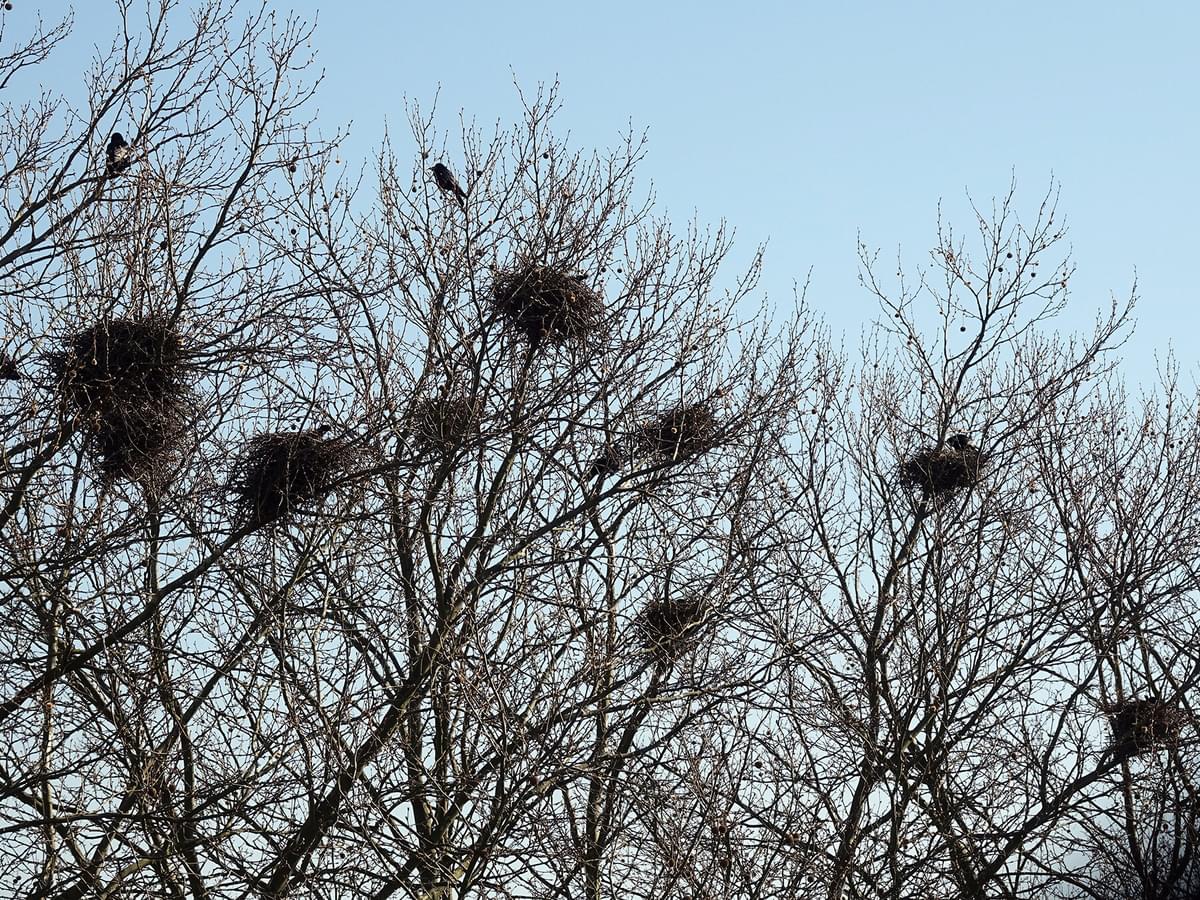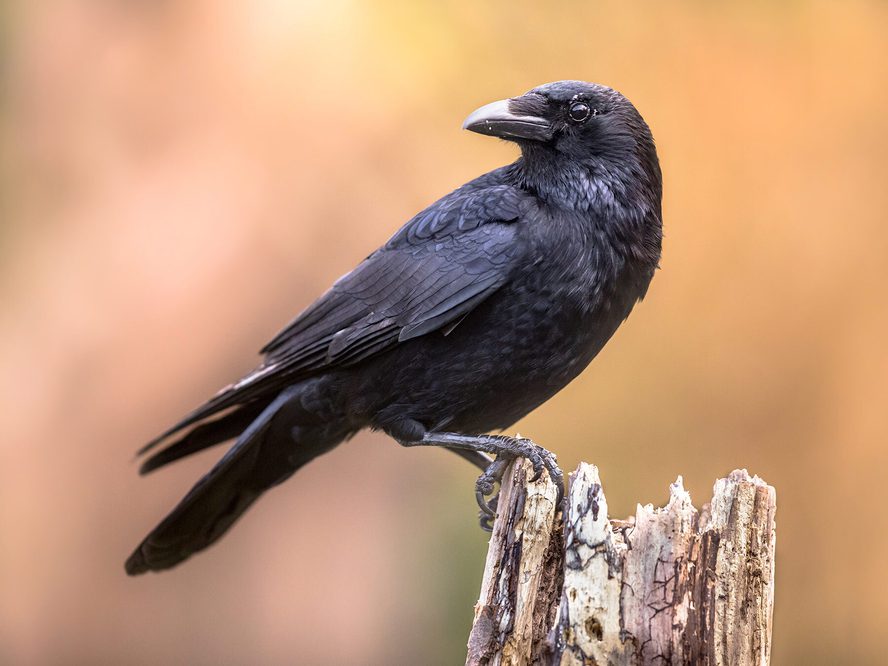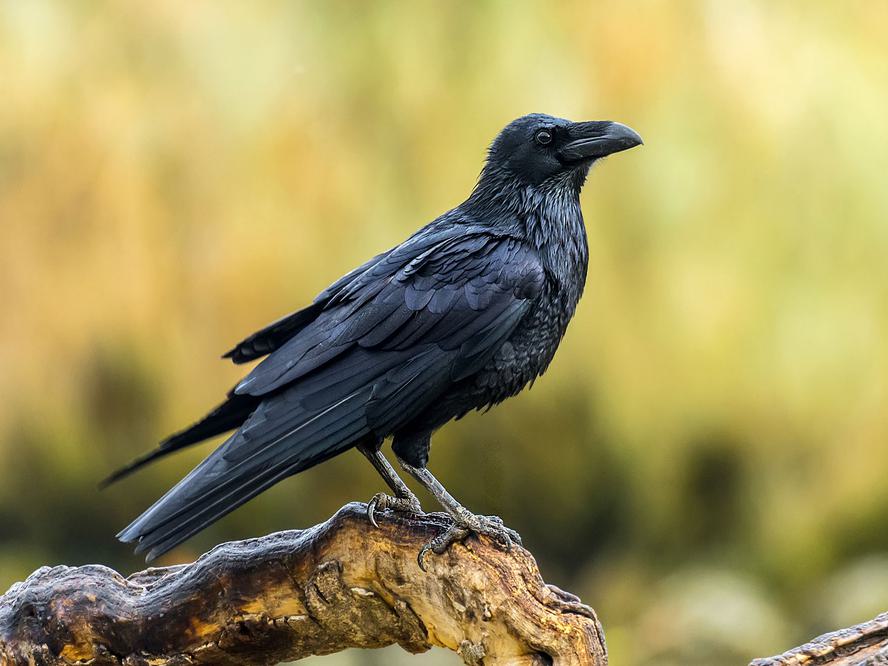Jump to Section
Crow Nesting (Behavior, Location, Eggs + FAQs)
Last updated: 1 February 2023

Crows are a key member of the highly intelligent Corvidae family (aka. the corvids). Crows are incredibly resourceful, and there are some 45 species distributed throughout much of the world, stretching from the furthest reaches of northern Europe to the tropical forests of South Asia.
Here we’re going to discuss a lesser-known aspect of crow behaviour to answer the questions; all about crows nests and behavior.
Many species of crows are incredibly flexible regarding their habitat. For example, the Carrion crow nests in tall buildings and skyscrapers, cliffsides, trees, hedgerows and even on the ground. Broadly, most species of crows prefer to nest in tall structures and choose the upper canopy of a deciduous or coniferous tree if possible. However, this is only a loose rule of thumb, and crows aren't that picky with their nesting sites.
You might have heard of the term 'crows nest', referring to a structure in the upper part of a sailing ship's mast. A ship's crow's nest is used as a lookout and is named so because crows like to nest in high-up places.
However, when you delve into crow nesting data, it's pretty clear that they're extraordinarily flexible and nest pretty much anywhere they deem safe. For example, one study found that as many as 45% of American crow nests were built on the ground.
There's certainly more to find out; read on to learn more about the nesting habits of the wonderfully intelligent crow!
| Key Crow Nesting Facts | |
|---|---|
| Nesting season | March to May |
| Nesting material | Small sticks, grasses and plant stems |
| Nest type | Large and bulky cup |
| Nest location | Highly variable, but prefers well-covered trees with broad branches and solid tree forks |
| Number of broods | One |
| Clutch size | 4 - 5 eggs |
| Egg color | Olive-green or blue-green, with brownish markings |
| Egg size | 26 to 31 mm (American Crow) |
| Egg weight | 17 g |
| Incubation period | 16 - 18 days, by the female |
| Fledgling period | 30 days |
| Reuse nests | Most build a new nest, but may occasionally repair old nests |
| Use nest boxes | No |

Carrion Crow (Corvus corone) sat on the nest
Where do crows nest?
Crows nest practically anywhere, ranging from the ground to tall skyscrapers. Most species of crows are not particularly fussy with where they nest, but their preferred habitat is tall, well-covered trees with broad branches and solid tree forks. They’ve even been recorded nesting in the sides of cliffs, brick walls and mountainside rock formations.
The average height of a crow’s nest is typically above 10m, sometimes extending up to 50m or higher. But, crows also often build their nests close to the ground or even on the ground. For example, one study of American crows in Mandarte, British Columbia, found that some 45% of nests were built on the ground. Meanwhile, in New York, Virginia and Ontario, the average nest height was some 10 to 20m.
The diversity of crow nesting sites is yet another indicator of how resourceful and adaptable this ingenious bird is.

Tail of an American crow (Corvus brachyrhynchos) over the edge of its nest, high up in a tree
What do crow nests look like?
Crow nests are large and bulky, and they consist of relatively small sticks about the length of a pencil. The average Carrion crow nest measures around 45cm (1.5ft) across and 18 to 25cm (8 to 10in) deep. Where there’s a shortage of dead twigs available, crows often turn to long grass and plant stems as an alternative. The overall nest shape is like a cup.
Once the superstructure is complete, the nest is lined with smaller and softer materials, including bark, grass, twine, paper, leaves, moss, mud and dung. Finally, a further inner liner is made from animal fur, mosses and other soft organic matter. The resulting nest is quite large - larger than you might expect for a bird of the crow’s size.
Studies have revealed that crows’ nests can be sturdy and persist for several years and may even be used by other birds after the crows leave (though they usually collapse during the winter). Moreover, crows may build a backup nest in the same tree or nesting site if the first one fails. There have even been reports of crows building three nests!

The nest of a hooded crow (Corvus cornix) with five eggs inside
What time of year do crows nest?
In North America and northern Europe, crows typically start building their nests in late winter (February to early March) and spring (April to May). Nest building gets into full swing during sunnier March days but may persist all the way into June if conditions or poor or nests fail.
The further south you go, the more erratic the breeding season becomes. For example, the Cape crow of Africa builds nests in December to February in Sudan, February to May in Eritrea and Ethiopia and March to April in Kenya. The Large-billed crow (or Jungle crow) also nests throughout much of the year in Asia, depending on the habitat and conditions.
How long do crows nest for?
Crows are flexible with their nests and may return to the same one year-on-year, or may choose to rebuild a new nest nearby. Some crows migrate, but they typically return to the same breeding grounds year on year.
Crows nest for at least the duration of the breeding season. Baby crows fledge after approximately one month but can stay with their parents for months longer or even years.
In fact, crows are one of few species of birds that have ‘nest helpers’. Young crows may stick around and help their parents build a nest and raise new young, their younger brothers and sisters!

A pair of crows, communicating with one another
How do crows build their nests?
Male and female crows usually work together to build the nest, but sometimes, the male will transport sticks to the nest for the female to construct and combine together. For example, the female American crow is observed doing much of the ‘fine tuning’ while the male supplies materials.
Crows sometimes have nest helpers, which are other non-breeding crows that join in to help build the nest. Nest helpers are often last year’s young or other birds related to the parents.
Nest building can get pretty chaotic when there is more than one helper. One birdwatcher observed several crows delivering sticks to a single female nest builder. She couldn’t use the materials fast enough, thus rendering the nest a chaotic mess! It can be a case of “too many crows spoil the broth” rather than “many crows make light work”!

Jackdaw (Corvus monedula) gathering nesting materials in spring
When do baby crows leave the nest?
Baby crows take around 25 to 35 days to fledge, at which point they’ll usually hop out of the nest and perch on a nearby branch.
Baby crows can spend as many as ten days perching in the tree canopy before flying for the first time. After baby crows fledge, they often stay under the close protection of their parents for at least two to three months.
How many broods do crows have?
Crows have one brood of young a year, but will often try for a second brood if the first fails sufficiently early in the breeding season.
Some species of crow have been recorded having two broods, such as the Cape crow and, rarely, the Hooded crow. Crow parents are dedicated and put a huge amount of effort into raising their brood - they rarely have time to have two broods.

Carrion Crow gathering nesting materials to build the nest
Do crows nest in the same place every year?
Most crows choose to build a new nest each year, but some choose to rebuild or repair old nests. It mostly depends on the availability of fresh nesting sites and new material - repairing and renovating might be a good choice when nesting sites are limited.
Even when crows don’t nest in the same exact nest, they do usually breed in the same area every year. Migratory crows typically return to the same breeding site each year, but many species of crows are resident and sedentary and don’t move too far from their natal home.
What do crow eggs look like?
Virtually all crow eggs are either olive-green or blue-green.
Carrion crow eggs are bluer whereas American crow eggs are more olive. In addition, Crow eggs are blotchy with grey-brown markings - most of the blotches are concentrated towards the wider end of the egg.
American crow eggs typically measure 2.6 to 3.1cm (1 to 1.2in). They vary in shape too; some are more elliptical, and some are more oval.

Crow feeding chicks in the nest
What month do crows lay eggs?
In much of North America, Europe and North and Central Asia, crows lay eggs in the typical breeding season, which runs from early April through to June. In the UK, most crows lay eggs in April and May.
In Africa and some parts of Asia, crows can lay eggs in December, January and February, or August, September and October. The traditional breeding season becomes more disjointed the further south you go.
Do crows use nest boxes?
Crows are too large for most common nesting boxes and, as a result, don't tend to utilise nesting boxes.
Crows also prefer to nest in more open areas, though they are flexible and sometimes choose some strange places to build nests. Even so, crows prefer to build open nests and rarely nest inside tree hollows or nesting boxes.

A crow sat on the nest
Where do crows sleep at night?
At night, crows sleep on tree branches or in open buildings.
Most species of crows are communal roosters, meaning that they gather together in flocks to roost at night, especially in colder conditions. In towns and cities, it’s pretty common to see crows gather in their hundreds in their roosts each night.
In addition, crows often enter cities to sleep at night, probably because it’s warmer and well-protected from nocturnal predators such as owls.
On this page
- Where do crows nest?
- What do crow nests look like?
- What time of year do crows nest?
- How long do crows nest for?
- How do crows build their nests?
- When do baby crows leave the nest?
- How many broods do crows have?
- Do crows nest in the same place every year?
- What do crow eggs look like?
- What month do crows lay eggs?
- Do crows use nest boxes?
- Where do crows sleep at night?








